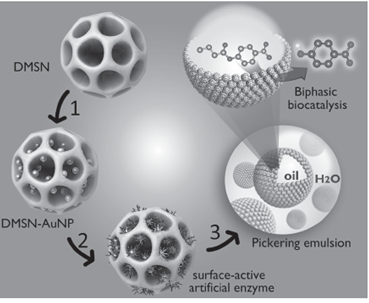We have demonstrated the first example of the fabrication surface-active artifi cial enzymes (SAE) as a new generation of interfacial biocatalysts for high-performance biocatalysis in Pickering emulsions. By using peptide molecules, metal complexes, and DNAzymes as the catalytic units, it was easy to build a diversity of SAE with esterase-, phosphotriesterase-, and peroxidase-like activities for rapid bioprocessing of hydrophobic reactants. Signifi cantly, we proved that the location of SAE particles at Pickering emulsion droplet interfaces greatly enhanced their catalytic activity due to the maximized oil–water interfacial area and facilitated mass transfer. Most importantly, compared to native proteins, SAE behaved as robust biocatalysts that withstand prolonged exposure to aqueous–organic interfaces with negligible loss of activity. Overall, the low cost, easy preparation, high stability, and good re-usability of SAE offer promising features toward the design and construction of alternative types of interfacial biocatalysts in Pickering emulsions for potential applications in biotechnology, industrial synthesis, and environmental protection. (Adv. Mater. 2015, DOI: 10.1002/adma.201504557)


